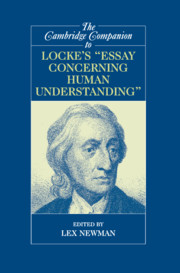Book contents
- Frontmatter
- Introduction
- 1 The Intellectual Setting and Aims of the Essay
- 2 Locke’s Polemic against Nativism
- 3 The Taxonomy of Ideas in Locke’s Essay
- 4 Locke’s Distinctions between Primary and Secondary Qualities
- 5 Power in Locke’s Essay
- 6 Locke on Substance
- 7 Locke on Ideas of Identity and Diversity
- 8 Locke on Ideas and Representation
- 9 Locke on Essences and Classification
- 10 Language, Meaning, and Mind in Locke’s Essay
- 11 Locke on Knowledge
- 12 Locke’s Ontology
- 13 The Moral Epistemology of Locke’s Essay
- 14 Locke on Judgment
- 15 Locke on Faith and Reason
- Bibliography
- Index of Names and Subjects
- Index of Passages Cited
3 - The Taxonomy of Ideas in Locke’s Essay
Published online by Cambridge University Press: 28 July 2007
- Frontmatter
- Introduction
- 1 The Intellectual Setting and Aims of the Essay
- 2 Locke’s Polemic against Nativism
- 3 The Taxonomy of Ideas in Locke’s Essay
- 4 Locke’s Distinctions between Primary and Secondary Qualities
- 5 Power in Locke’s Essay
- 6 Locke on Substance
- 7 Locke on Ideas of Identity and Diversity
- 8 Locke on Ideas and Representation
- 9 Locke on Essences and Classification
- 10 Language, Meaning, and Mind in Locke’s Essay
- 11 Locke on Knowledge
- 12 Locke’s Ontology
- 13 The Moral Epistemology of Locke’s Essay
- 14 Locke on Judgment
- 15 Locke on Faith and Reason
- Bibliography
- Index of Names and Subjects
- Index of Passages Cited
Summary
According to Locke's theory, ideas are the building materials of human understanding. They compose and combine in several ways. There are two main types of ideas, simple and complex, and there are several types of complex ideas differentiated by modes of construction. Moreover, although ideas direct the mind to objects of thought, ideas do not attain truth or falsity. Propositions, not ideas, are strictly true or false, according to the Essay; but propositions are composed of ideas and connective mental acts. The Essay is ultimately concerned with propositions, because they are what we know, believe, or judge to be true. The treatise aims to explicate the “Original, Certainty, and Extent of humane Knowledge; together with the Grounds and Degrees of Belief, Opinion, and Assent” (E I.i.2: 43). These topics are reached in Book IV after a thorough inquiry into the origin of the various types of ideas in Book II and an examination of names in Book III. The antecedent material on ideas is theoretical ground for the subsequent linguistic and epistemic theories. Names are typed and characterized in accord with the sorts of ideas that determine their signification. Propositions, too, are divided into types that have distinctive epistemic properties in virtue of the sorts of ideas that enter into their composition. The main purpose of this Essay is to bring out the systematic theoretical uses to which Locke puts the taxonomic scheme, as well as to trace some strains they put on the classification.
- Type
- Chapter
- Information
- Publisher: Cambridge University PressPrint publication year: 2007
- 7
- Cited by

